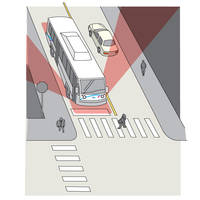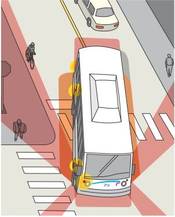Sharing the Road with Buses
June 6 to 10 is Public Transportation Road Safety Week across Quebec! We are taking advantage of this theme week to talk about the highway code, but also especially about good habits to adopt. All because we are concerned about keeping you safe!
- Because you are not always visible to the driver, learn more about a buse's blind spots.
- See our advice regarding the best way to travel safely by bike.
- See why it is important to use the crossings for pedestrians and cyclists to cross the Rapibus corridor.
The Société de transport de l'Outaouais (STO), in collaboration with the Société de l'assurance automobile du Québec and Action Vélo Outaouais, has developed a few safety tips so we can all graciously share the roads with the buses.
The STO wants everyone using the roads to be safe. So please be sure to follow these tips.
Watch for blind spots!

A bus's blind spots are the parts of the road that the driver cannot see because of the size of the bus.
Buses have blind spots at the front and rear on both sides of the vehicle. It is impossible for the driver to see everywhere at all times. Keep your distance so that you are visible at all times.
Right turns
Articulated buses
Articulated buses have bigger blind spots than standard buses. Furthermore, articulated buses may cross the dividing line between lanes in order to make some turns.
Did you know that...
- In an emergency, on a dry road, a bus travelling at 50 km/h needs 29 metres to stop. Imagine a full bus on a day when it is raining or snowing.
- Buses travel at an average speed of 40 to 50 km/h. Faster than you, right? If you are in front of a bus at a red light, pull over to the right and let the bus go first. This way the driver avoids having to pass you.
More safety tips
If you share the road with the STO, remember:
- Other than motor vehicles, only motorcycles and bicycles are permitted to ride on the roads. Observe all traffic signs and comply with the Quebec Highway Safety Code.
- It is prohibited and very dangerous to touch or grab a moving or stopped bus.
- Keep a safe distance away from a bus. When passing, leave at least one metre of space.
- Be seen: make eye contact with the driver and signal your intentions.
- Be visible: wear brightly coloured clothing with reflective strips.
- Use the pedestrian crossing to cross roads, and check that you can cross safely. Observe the vehicle traffic lights if there are no pedestrian lights.







